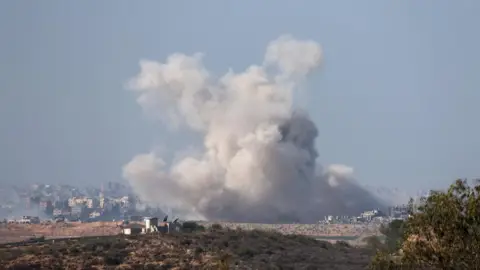Why has the Gaza ceasefire come to an end?
 EPA
EPAFighting resumed between Israel and Hamas on Friday morning, ending a seven-day ceasefire between the two sides that had seen hostages and prisoners released and much-needed humanitarian assistance reaching the Gaza Strip.
Here's a look at some of the key questions around the latest developments.
Why did the ceasefire end?
An hour before the ceasefire was due to end at 07:00 local time (05:00 GMT), the Israel Defense Forces (IDF) reported that sirens were sounding for communities close to the Gaza Strip - it then said it had intercepted a rocket fired from the enclave.
An hour later, Israel's military said fighting had resumed, accusing Hamas of violating the terms of the agreement.
The IDF then said its fighter jets were striking Hamas targets in the Gaza Strip.
Shortly after, Israel's Prime Minister Benjamin Netanyahu said Hamas had not "met its obligation to release all of the women hostages today and has launched rockets at Israeli citizens".
However, Hamas blamed Israel for the resumption in fighting, saying it refused "to accept all offers to release other hostages".
"The occupation had a prior decision to resume the criminal aggression," it said in a statement, blaming US President Joe Biden for "the continuation of Zionist war crimes in the Gaza Strip" and "giving the green light to Israel".
Throughout the week-long ceasefire, Mr Netanyahu has come under pressure, particularly from right-wing elements in his government, to re-start the war - something Israel has continually made clear it intended to do once the agreement had come to an end.
Despite this, there are still hopes that a new agreement could be reached. Qatar, which has played a crucial role so far in negotiations over a ceasefire, confirmed on Friday that talks were continuing "with the aim of returning to a pause".
What's the situation in Gaza?
Within seven hours of the fighting resuming, the Hamas-run health ministry said more than 60 people had been killed, adding to the nearly 15,000 Palestinians it said were killed before the ceasefire.
James Elder from Unicef, the UN children's agency, spoke to the BBC from a hospital in southern Gaza after the bombing started, describing the situation as "terrifying".
He said it was "horrendous for people" and that "you see the fear on their faces", adding that a strike had hit close to the facility he was in.
He described the end of the ceasefire as "the nightmare that everyone utterly feared".
Before the ceasefire, the Gaza Strip had undergone widespread destruction as Israel conducted its retaliatory campaign in response to Hamas's deadly 7 October attacks.
Israel claimed to have used more than 10,000 bombs and missiles, and BBC analysis found that almost 98,000 buildings in Gaza may have suffered damage, with most concentrated in the north.
The strikes also brought humanitarian aid to a halt. Aid agencies were able to use the pause in fighting to get crucial assistance in, but reported finding devastation in many of the areas they reached.
What happens next?
Although negotiations continue in the hope of a new deal being reached, for now it's clear that the war has resumed.
After weeks of intense fighting in the north of the Gaza Strip - particularly around Gaza City - Israel's military now appears to be focussing much of its attention on the south, where renewed air strikes have been reported.
The IDF has also created a map of Gaza divided into more than 2,000 zones, which it said will be used to help people in Gaza escape future fighting. It said the map is split into areas to enable people to "evacuate from specific places for their safety if required".
On Friday, Israeli jets dropped leaflets over areas east and north of Khan Younis, the largest city in southern Gaza, linking to the map. The flyers did not refer to any of the numbered blocks, but a message in Arabic told residents in four named - but not numbered - areas to "evacuate immediately and go to shelters in Rafah".
The renewed fighting comes after US Secretary of State Antony Blinken met with Israeli officials, where he insisted the next stage of the war must ensure civilians are protected.
Mr Blinken said he had told the Israeli government that it must avoid further mass displacement of Palestinians and damage to critical infrastructure, such as hospitals, power stations and water facilities.
What happened during the ceasefire?
During the seven-day ceasefire, Hamas agreed to release 110 people from Gaza, including 78 Israeli women and children.
As part of the deal, 240 Palestinians were also released from Israeli jails. They had been accused of a range of offences, from throwing stones to incitement and attempted murder.
Many of the Palestinians released had not been convicted of crimes, and were being held on remand while awaiting trial. Some said they had been subjected to abuse and collective punishment after the 7 October attacks. Israel says all its prisoners are detained according to the law.
It is estimated that about 140 Israeli hostages remain in captivity in Gaza.

More on Israel-Gaza war
- Follow live: Latest updates
- Hostages: Wounded festival-goer in Hamas video freed
- Prisoners: Released Palestinians allege abuse in Israeli jails
- Explained: Who are the hostages released from Gaza?
- In Gaza: How much damage has been done?
- History behind the story: The Israel-Palestinian conflict


More on Israel-Gaza war
- Follow live: Latest updates
- Hostages: Wounded festival-goer in Hamas video freed
- Prisoners: Released Palestinians allege abuse in Israeli jails
- Explained: Who are the hostages released from Gaza?
- In Gaza: How much damage has been done?
- History behind the story: The Israel-Palestinian conflict

